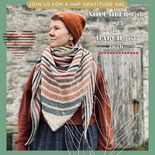patterns > The Shetland Trader >  The Shetland Trader, Book Three: Heritage
The Shetland Trader, Book Three: Heritage
> Vatna









Vatna
Order your copy here! Gudrun Johnston joins forces with Pom Pom Press for the latest instalment of her Shetland Trader series. This third volume explores the very roots of the series: the made-to-order knitwear business run in the 1970s by Patricia Johnston, Gudrun’s mother, which operated as The Shetland Trader.
Through archival research and a network of family, friends, and fibre enthusiasts, Gudrun has unearthed some of her mother’s best-loved designs and updated them for contemporary knitters. This collection contains 11 patterns for garments and accessories. Use them to create seventies-inspired dream ensembles as well as heirloom pieces incorporating traditional Shetland knitting techniques and motifs.
Vatna and Tarra are companion shawls using the Razor Shell lace pattern. Vatna is the larger version.
One Size:
Wingspan: Approx 134cm / 52¾“ Depth: 67cm / 26½”
Yarn (fingering / 4-ply-weight yarn in the following amounts):
Jamieson & Smith 2ply Jumper Weight (fingering / 4-ply-weight; 100% Real Shetland Wool; 115m / 125yds per 25g ball) MC: Shade 32; 5 balls
CC1: Shade 54; 2 balls
CC2: Shade FC61; 1 ball
CC3: Shade 125; 1 ball
OR approx
MC: 570m / 620yds
CC1: 155m / 165yds
CC2: 105m / 110yds
CC3: 75m / 80yds
Gauge:
19 sts & 26 rows = 10cm / 4” over Razor Shell Pattern on 4.5mm needles after blocking
19 sts & 24 rows = 10cm / 4” over Garter Stitch on 4.5mm needles after blocking
Needles:
4.5mm / US 7 circular needle, 60cm / 24” and 100cm / 40” length
5.5mm / US 9 circular needle, 100cm / 40” length (for the cast on)
Always use a needle size that will result in the correct gauge after blocking.
Notions:
3 stitch markers, 1 locking stitch marker (optional), tapestry needle for weaving in ends
Notes:
The shawl is worked from the outside in, starting with the widest edge. The body of the shawl is shaped by decreases that are evenly distributed across the main fabric until only a few stitches remain.

31017 projects
stashed
46963 times
- First published: October 2021
- Page created: September 23, 2021
- Last updated: March 24, 2023 …
- visits in the last 24 hours
- visitors right now





